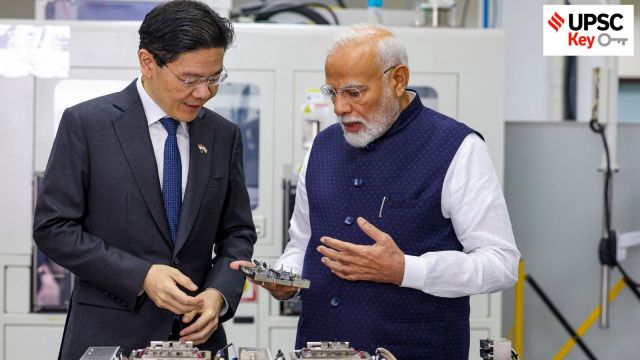🚨 The Indian Express UPSC Essentials brings to you the August edition of its monthly magazine. Click Here to read. Share your views and suggestions in the comment box or at manas.srivastava@indianexpress.com🚨
Explained
UPSC Syllabus:
Preliminary Examination: Current events of national and international importance
Mains Examination: GS-II, III: International Relations, Economy
What’s the ongoing story- Prime Minister Narendra Modi visited Singapore during the second leg of a two-nation trip to South-East Asia this week, having travelled to Brunei Darussalam in the first leg. It was the first visit by an Indian Prime Minister to Brunei, and Modi’s fifth trip to Singapore.
Prerequisites:
— Focus areas: ASEAN, India’s Act East Policy, and Indo-Pacific vision
— What is the significance of semiconductors for India?
— What is the India Semiconductor Mission?
Key takeaways:
— The Singapore leg of the Prime Minister’s visit was marked by agreements on semiconductors, digital technologies, health and skill development.
— Given the critical importance of semiconductor chips in virtually everything from missiles to mobile phones and from cars to computers, the pact with Singapore has great geo-strategic and geo-economic importance.
Story continues below this ad
— Supply disruptions during the Covid-19 pandemic and the geopolitical tensions arising out of China’s aggressive moves in the Taiwan Strait and the South China Sea have brought great urgency to India’s efforts to develop its own semiconductor ecosystem. The global chip industry is dominated by companies from a very small number of countries, and India is a late entrant into this high-tech and expensive race.
— The India Semiconductor Mission was launched in 2021 with a Rs 76,000 crore chip incentive scheme, under which the central government offered half the plant’s capital expenditure costs as subsidy. In February, the Cabinet approved semiconductor-related projects adding up to investments of about Rs 1.26 lakh crore.
— That same month, the government announced a partnership between the Tata Group and Taiwan’s Powerchip Semiconductor Manufacturing Corporation (PSMC) to set up a semiconductor fabrication plant. The Cabinet has so far approved five semiconductor units, including four assembly units, under the incentive scheme.
— Today, Singapore contributes around 10% of the global semiconductor output, along with 5% of the global wafer fabrication capacity and 20% of semiconductor equipment production.
Story continues below this ad
— What worked especially for Singapore were infrastructure and connectivity, stable business conditions, a critical mass of leading companies based in the country covering the full value chain from design to testing, and suitable human capital.
— In the view from New Delhi, Singapore’s semiconductor industry is limited to “mature-node chips” (process node technology of 28 nm or more), which are used in appliances, cars, and industrial equipment. It is not equipped to make high-end logic chips like the ones used in the AI sector (process nodes of 7 nm and smaller, requiring specialised production methods).
— As the costs of production increase, semiconductor companies are seeking to diversify some low-cost and labour-intensive operations out of Singapore.
— From New Delhi’s perspective, there is scope for collaboration with Singapore in talent development, and knowledge-sharing about best practices in managing semiconductor industrial parks (called Wafer Fab Parks in Singapore).
Story continues below this ad
— India’s abundant land and competitive labour costs could encourage semiconductor companies in Singapore to look at the country for their expansion plans. There is also scope for India to engage and collaborate with semiconductor equipment and material manufacturers in Singapore to develop its own semiconductor manufacturing ecosystem.
For Your Information:
— Singapore is an important facilitator of India’s Act East policy, Modi said.
— Underlining the strategic partnership between India and Singapore, Modi said: “Over the past 10 years, our trade has more than doubled. Mutual investment has increased almost threefold to cross US$150 billion. Singapore was the first country with which we launched the UPI person-to-person payment facility.”
— In 2025, the India-Singapore relationship will celebrate its 60th anniversary. To mark this occasion, he called on both countries to collaborate on an action plan.
Points to Ponder:
Story continues below this ad
— What are the various agreements signed by India with other countries on cooperation in semiconductor technology?
— What are the schemes launched by the Indian government for the manufacturing of semiconductors?
— What are the challenges of the development of semiconductors in India?
Post Read Question:
(1) With reference to Semiconductor industry, consider the following statements :
1. The Indian government has created a dedicated task-force called the India Semiconductor Mission, which aims to serve as a focal point for an efficient implementation of India’s chip ambitions.
Story continues below this ad
2. More than 90 per cent of the world’s most advanced chips required for almost all electronic equipment such as smartphones, car components, data centres, fighter jets and AI technologies, are made in South Korea.
Which of the above statements is/are correct?
(a) 1 only
(b) 2 only
(c) Both 1 and 2
(d) Neither 1 nor 2
Other Important Articles Covering the same topic:
‘Strategic partnership’: India, Singapore sign MoUs on semiconductors, digital tech
UPSC Syllabus:
Preliminary Examination: Current events of national and international importance
Mains Examination: GS-II: Polity, Constitution
What’s the ongoing story- The Union government has notified the constitution of the 23rd Law Commission of India with effect from September 1. The commission, which was notified on September 2, will have a three-year term. The tenure of the previous Law Commission chaired by former Karnataka High Court Chief Justice Ritu Raj Awasthi ended on August 31.
Prerequisites:
— What is the function of the Law Commission?
Key takeaways:
Story continues below this ad
— The Law Commission is a non-statutory commission (not created by a law of Parliament) formed by the Union Ministry of Law and Justice through a gazette notification to help the government review functioning of laws, suggest repealing of obsolete legislation, and make recommendations on matters referred to it by the government.
— The commission is usually chaired by a retired judge of the Supreme Court or a High Court, and has legal scholars as members. Serving judges can also be appointed to the commission, according to the notification on the appointment of the new panel.
— The 22 Law Commissions appointed since Independence have submitted a total 289 reports to the government. The government is under no obligation to accept the reports; however, the commissions’ recommendations have over the decades led to the enactment of important legislation including the Code of Criminal Procedure, 1973 (CrPC), and the Right of Children to Free and Compulsory Education Act, 2009 (RTE Act).
— The September 2 notification issued by the Law Ministry’s Legal Affairs Department says the panel will have a full-time chairperson, four full-time members including a member-secretary, not more than five part-time members, and the secretaries of the Legal Affairs and Legislative departments as ex officio members. The commission’s term will be until August 31, 2027.
Story continues below this ad
— The chairperson and members of the 23rd Law Commission are yet to be named. The decision will be taken by the Appointments Committee of Cabinet chaired by the Prime Minister, government sources said.
— A serving judge, if appointed to the commission, serves until retirement or expiry of the panel’s term, whichever is earlier, and gets no additional remuneration apart from the usual judge’s salary.
— The 22nd Law Commission presented 11 reports, including one in April 2023 that recommended that Section 124A of the Indian Penal Code, the widely criticised law against sedition, should be retained.
— This March, the commission presented a report recommending a new law to protect trade secrets. It also worked on a report on simultaneous elections, but this report, like that on the Uniform Civil Code, was not presented to the government.
Points to Ponder:
— Evolution of Law Commission in India
— What are the important recommendations made by the Law Commission?
Post Read Question:
(2) The power to increase the number of judges in the Supreme Court of India is vested in (UPSC CSE 2014)
(a) the President of India
(b) the Parliament
(c) the Chief Justice of India
(d) the Law Commission
Other Important Articles Covering the same topic:
Govt sets up 23rd Law Commission for legal reforms
UPSC Syllabus:
Preliminary Examination: Current events of national and international importance
Mains Examination: GS-III: Science and technology
What’s the ongoing story- The United States, the European Union, and the United Kingdom (UK) are expected to sign the Council of Europe’s convention on artificial intelligence (AI), the first “legally binding” international treaty on the use of the revolutionary new technology, on Thursday (September 5).
Prerequisites:
— What do you understand by ‘legally binding’?
— What is Artificial Intelligence?
— What is the Bletchley Declaration?
Key takeaways:
— The treaty, which prioritises human rights in its approach to the regulation of public and private-sector AI systems is seen as the first real agreement among the key players in the development of AI, amid concerns that disparate regulations proposed by individual countries could hinder the evolution of this technology.
— The treaty, officially known as the Council of Europe Framework Convention on Artificial Intelligence and Human Rights, Democracy and the Rule of Law, was opened for signature during a conference of Council of Europe Ministers of Justice in Vilnius, Lithuania, on Thursday.
— The treaty that was drafted over the past 24 months by more than 50 countries adopts a risk-based approach to the design, development, use, and decommissioning of AI systems.
— Signatories will be accountable for “any harmful and discriminatory outcomes of AI systems”, and will ensure that “outputs of such systems respect equality and privacy rights, and that victims of AI-related rights violations have legal recourse”.
— There are a few exemptions in the scope of applicability of the Framework Convention, such as national security and research and development. The treaty puts an obligation on parties to address the risks posed by activities within the lifecycle of AI by public and private actors.
— The treaty comes at a time when sovereign governments and smaller multilateral groups have come up with a clutch of new regulations and agreements to oversee AI tools, including the G7 pact on AI (October 2023), Europe’s AI Act, and Bletchley Declaration signed by 28 countries (November 2023).
— Even though the treaty is being called “legally binding”, there are concerns that it does not contain provisions for punitive sanctions such as penalties or fines.
For Your Information:
— Even as the private industry innovates rapidly, lawmakers around the world are grappling with setting legislative guardrails around AI to curb some of its downsides. Recently, the IT Ministry issued an advisory to generative AI companies deploying “untested” systems in India to seek the government’s permission before doing so.
— However, after the government’s move was criticised by people from across the world, the government scrapped the advisory and issued a new one which had dropped the mention of seeking government approval.
— Last year, the EU reached a deal with member states on its AI Act which includes safeguards on the use of AI within the EU, including clear guardrails on its adoption by law enforcement agencies. Consumers have been empowered to launch complaints against any perceived violations.
Points to Ponder:
— What are the human rights concerns associated with AI?
— Regulation of AI in India
— What are the challenges posed by AI?
Post Read Question:
(3) With the present state of development, Artificial Intelligence can effectively do which of the following? (UPSC CSE 2020)
1. Bring down electricity consumption in industrial units
2. Create meaningful short stories and songs
3. Disease diagnosis
4. Text-to-Speech Conversion
5. Wireless transmission of electrical energy
Select the correct answer using the code given below:
(a) 1, 2, 3 and 5 only
(b) 1, 3 and 4 only
(c) 2, 4 and 5 only
(d) 1, 2, 3, 4 and 5
Other Important Articles Covering the same topic:
The US and the UK sign agreement on AI safety testing: What is the deal?
Front
UPSC Syllabus:
Preliminary Examination: Current events of national and international importance
Mains Examination: GS-II: Government policies and interventions
What’s the ongoing story- Access to toilets and better sanitation services under the government’s Swachh Bharat Mission may have averted around 60,000 to 70,000 infant deaths annually between 2014 and 2020, a study published in the journal Nature has found.
Prerequisites:
— What is the Swachh Bharat Mission (SBM)?
— What are the various components of SBM?
— What is the Infant Mortality Rate (IMR)?
Key takeaways:
— Launched on October 2, 2014, over 11 crore household toilets were built under Swachh Bharat Mission-Grameen as of 2020, and over six lakh villages were declared Open Defecation Free, according to government data. Under Swachh Bharat Mission-Urban, over 63 lakh individual household toilets and 6.36 lakh community public toilets have been built.
— Establishing an inverse relation between access to toilets and infant mortality, the study stated that even districts with 30 per cent toilet coverage had managed to reduce the infant mortality rate by a substantial number. In absolute numbers, it amounted to averting 60,000-70,000 deaths annually across the country.
— In 2012, the infant deaths reported was 40 per 1,000 live births per district which fell to about 33 in 2016 and further dropped below 30 by 2019. Likewise, the deaths of children under the age of five in 2012 was about 44 per 1,000 live births per district. It dropped to below 40 in 2014, 35 in 2016 and in 2019, it was below 30.
For Your Information:
— The launch of the Swachh Bharat Mission (SBM) by the Prime Minister on October 2, 2014, had a unique goal — to achieve universal sanitation coverage and to make the country Open Defecation Free (ODF). By offering financial incentives for building household toilets, as well as community toilets for slums and migrant populations, the government gave a huge fillip to the toilet infrastructure.
— The second phase of the project, which commenced in 2020 and is expected to run till 2025, has set even more ambitious targets — sustaining the achievements of phase 1 and ensuring that treatment of both liquid and solid waste is achieved through the help of technology and private sector engagement.
Points to Ponder:
— What are the challenges of SBM?
— What steps need to be taken by the government to address these challenges?
— How Open Defecation Free is related to the decline in IMR?
Post Read Question:
Prelims
(4) As per the Solid Waste Management Rules, 2016 in India, which one of the following statements is correct? (UPSC CSE 2019)
(a) Waste generator has to segregate waste into five categories.
(b) The Rules are applicable to notified urban local bodies, notified towns and all industrial townships only
(c) The Rules provide for exact and elaborate criteria for the identification of sites for landfills and waste processing facilities.
(d) It is mandatory on the part of the waste generator that the waste generated in one district cannot be moved to another district.
Mains
How could social influence and persuasion contribute to the success of Swachh Bharat Abhiyan? (UPSC CSE 2016)
Other Important Articles Covering the same topic:
Swachh Bharat 2.0: Moving forward together
UPSC Syllabus:
Preliminary Examination: Current events of national and international importance
Mains Examination: GS-II: Polity, Constitution
What’s the ongoing story- The Public Accounts Committee (PAC), the parliamentary watchdog for government spending, has decided to include in its agenda for the year a review of the performance of the Securities and Exchange Board of India (SEBI) whose chairperson Madhabi Puri Buch is at the centre of a political firestorm following allegations levelled against her by US-based Hindenburg Research.
Prerequisites:
— What is the Public Accounts Committee (PAC)?
— What are regulatory bodies?
— What are the different committees of the Parliament?
Key takeaways:
— The PAC, headed by Congress senior leader K C Venugopal, took the unusual step to include a suo motu subject – performance review of regulatory bodies established by Act of Parliament – at its last meeting on August 29. The agenda for the year was notified earlier this week.
— The 22-member PAC has 15 MPs from Lok Sabha and seven from Rajya Sabha. Other than Venugopal, it has senior BJP leaders Ravi Shankar Prasad, Nishikant Dubey, K Laxman, Anurag Thakur, Jagdambika Pal and Sudhanshu Trivedi as its members.
— The PAC, one of the most significant parliamentary panels that audits the revenue and expenditure of the government, usually makes a selection of Audit Paragraphs included in the various reports of CAG for in-depth examination. In addition, the Committee can also select one or more suo motu subjects for in-depth examination during the year.
For Your Information:
— Parliamentary Committees have their origins in the British Parliament. They draw their authority from Article 105, which deals with the privileges of MPs, and Article 118, which gives Parliament authority to make rules to regulate its procedure and conduct of business.
— Broadly, Parliamentary Committees can be classified into Financial Committees, Departmentally Related Standing Committees, Other Parliamentary Standing Committees, and Ad hoc Committees.
— The Financial Committees include the Estimates Committee, Public Accounts Committee, and the Committee on Public Undertakings. These committees were constituted in 1950.
Points to Ponder:
— What is the function of the Comptroller and Auditor General (CAG)?
— What is the function of the Parliamentary Committee?
— What are the challenges of the Parliamentary Committee?
Post Read Question:
(5) Consider the following statements The Parliamentary Committee on Public Accounts (UPSC CSE 2013)
1. consists of not more than 25 Members of the Lok Sabha
2. scrutinizes appropriation and finance accounts of the Government
3. examines the report of the Comptroller and Auditor General of India
Which of the statements given above is/are correct?
(a) 1 only
(b) 2 and 3 only
(c) 3 only
(d) 1, 2 and 3
Other Important Articles Covering the same topic:
Parliament Committees, their leaders, and their role in law-making
The Ideas Page
UPSC Syllabus:
Preliminary Examination: Current events of national and international importance
Mains Examination: GS-II: Bilateral, regional and global groupings and agreements involving India
What’s the ongoing story- Sachin Chaturvedi writes: Prime Minister Narendra Modi, at the inauguration of the Third Voice of Global South Summit (VoGSS), attempted to rebalance the terms of South-South engagement with a new conceptual framework that he described as a “Development Compact”.
Prerequisites:
— What is the Voice of Global South Summit (VoGSS)?
— Learn about OECD, UNCTAD, WTO
Key takeaways:
— The idea behind the concept is to leverage five different modalities of engagement in a harmonised manner, where one reinforces the other. These are capacity building, technology sharing, trade for development, grants and the most important, concessional finance.
— Due to imbalances in the modalities of engagement, a large section of the Global South has ended up in indebtedness of distressing proportions. The figures from UNCTAD (2023) say it all: Developing countries’ public debt in 2023 was $29 trillion…
— It is extremely important for the Global South to go back to basics and revisit the idea of development which disappeared from the global policy landscape.
— There are five broad possibilities from the recent development initiatives in India that may be adapted for locally relevant ecosystems in the Global South. The first is in the realm of sustainability, wherein the emphasis is on Lifestyle for Environment (LiFE), re-energising SDGs and promoting renewable energy through rooftop solar panels and solar farms.
— The second is the area of promoting health security where the driving force for India is around the concept of “One World One Health”. Here, India’s contribution for Arogya Maitri may be recalled.
— The third is India’s emergence as the first responder in humanitarian crises, be that in Papua New Guinea, Kenya, Gaza and Ukraine…
— The fourth relates to promoting financial inclusion and last mile connectivity to be achieved through UPI and Digital Public Infrastructure.
— The fifth is the need for strengthening interlinkages in the field of education, skills and capacity building.
— At the VoGSS, the PM recalled India launching the Global South Centre of Excellence, called DAKSHIN, for knowledge promotion, experience sharing and evolving programmes for skills and capacity building. The role of such institutions is to promote a two way flow of knowledge and experiences.
— Prime Minister Modi’s emphasis on the Global South to come together for voicing their common concerns and also bringing in positive approaches for global solutions is an important call that should be heard earnestly by the Global South community.
— VOGSS as a platform to discuss some of these issues is an important initiative in a world where uncertainty and vulnerability have multiplied for democratically elected governments.
For Your Information:
— In the simplest sense, Global South refers to the countries of Asia, Africa, Latin America, and Oceania. Most of these countries, where 88 per cent of the world population lives, experienced colonial rule and historically lagged in achieving substantial levels of industrialisation.
— The developed countries of North America and Europe, on the other hand, are often referred to as the Global North. These countries have a history of pursuing imperial policies.
— According to the United Nations Conference on Trade and Development, Global South countries typically exhibit lower levels of development, higher income inequality, rapid population growth, agrarian-dominant economies, lower quality of life, shorter life expectancy, and significant external dependence.
Points to Ponder:
— What is the significance of the Voice of Global South Summit (VoGSS) for India?
— What are the challenges of the Global South?
— How can India become the leader of the Global South?
Post Read Question:
“If the last few decades were of Asia’s growth story, the next few are expected to be of Africa’s.” In the light of this statement, examine India’s influence in Africa in recent years. (UPSC CSE 2021)
Other Important Articles Covering the same topic:
As voice of Global South, India pushes for change in global order
Dis/Agree
UPSC Syllabus:
Preliminary Examination: Current events of national and international importance
Mains Examination: GS-II: Government policies and interventions
What’s the ongoing story- The rape and murder of a doctor at the R G Kar Medical College and Hospital has reignited the demand for stricter laws and the death penalty for rape. Unsurprisingly, the West Bengal government has significantly enhanced punishments for sexual offences against women and children in the Aparajita Woman and Child (West Bengal Criminal Laws Amendment) Bill, 2024 passed by the state assembly. Among the proposed enhancements is the mandatory death penalty for rape that results in death or permanent vegetative state of the victim.
Prerequisites:
— What are the laws about rape in India?
— What is capital punishment?
Key takeaways:
Harsher rape laws do little to prevent sexual violence
— Anup Surendranath and Neetika Vishwanath write: First, will harsher punishments contribute to preventing sexual violence in our society? Second, irrespective of its preventive potential, should we impose harsh punishments on individuals guilty of such offences as something that they “deserve”?
— Harsher laws are part of the established political playbook to quieten public clamour but can do very little to prevent incidence of sexual violence in our society. Instead, they play on society’s collective anger and desire to inflict harsh punishment in the immediate aftermath of such incidents.
— In our reflections on whether harsher laws will prevent sexual violence, we need to confront the actual source of sexual violence in our society.
— However, sexual violence is an outcome of deeply ingrained gender, caste, and religious hierarchies that routinely produce and legitimise sexual violence. Rape is an assertion of power. It is part of a larger spectrum of violence against women towards which there is widespread apathy in our homes, workplaces, institutions etc.
— Suggestions that the death penalty will deter offenders make flawed assumptions about the Indian criminal justice system… Conviction rates in rape cases are under 30 per cent.
— Challenges in effective and prompt investigations, concerns with prosecutorial capacity and quality, questions about the institutional capacity of courts to conduct fair trials without undue delay are all impediments to pursuing accountability for sexual violence.
— When the death penalty for rape fails on account of its ability to prevent rapes, it is justified as a proportionate response to a grave crime. Reasoning that rape without murder warrants the death penalty, a punishment also prescribed for ending another person’s life, reinforces the patriarchal logic that “rape is a deathless shame” for survivors.
— Putting the complete blame on perpetrators is highly self-righteous for a society that actively contributes to a culture that trivialises violence against women.
— We must recognise our hypocrisy in being selectively enraged about stranger rapes only when the bodies of victims bear marks of violence serious enough to shake our collective conscience.
— While there is no one way to tackle sexual offences, tougher laws and the death penalty are undoubtedly the wrong ones. We require broader social reforms, sustained governance efforts, and stronger criminal justice institutions.
Stricter rape laws are necessary
— Pinky Anand writes: The Indian juridical response to rape has been a long-drawn process, right from the case of Tukaram v State of Maharashtra in 1978 to Mukesh v State of GNCTD or the December 2012 gangrape case.
— Women have had to fight to be able to prove that they were raped, that the action was non-consensual and against the obstacles created in the name of the innocent-untilproven guilty doctrine.
— Women who report rapes are statistically more prone to violence and the police do not handle the matter with sensitivity. What it creates is an environment favourable to the predator, giving him the audacity to look at women solely from a lens of subjugation or pleasure.
— Stricter laws create a mindset where a perpetrator is afraid of the consequences. This deterrence is extremely necessary in today’s India. World over, we see that where the punishment for rape is swift and harsh, incidence of rape is much lower.
— There is an urgent need for deterrent laws. BNS, 2023 already encompasses stringent provisions for the punishment of rape and related offences. Sections 64, 66, 70(1), 71, 72(1), 73, 124(1), and 124(2) of the BNS provide a comprehensive legal framework addressing various aspects of sexual violence…
— Despite BNSS making laws stringent, the R G Kar rape case has still happened. This suggests that the current laws do not act as deterrent enough, that stricter laws are necessary.
— The West Bengal government has passed the Aparajita Woman and Child Bill (West Bengal Criminal Laws and Amendment) Bill 2024, which is a laudable step towards creating an environment where there is true deterrence.
Points to Ponder:
— What are the reasons for sexual violence against women?
— NCRB data on crimes against women
— What are initiatives taken by the government to ensure the safety of women?
Post Read Question:
We are witnessing increasing instances of sexual violence against women in the country. Despite existing legal provisions against it, the number of such incidences is on the rise. Suggest some innovative measures to tackle this menace. (UPSC CSE 2014)
Other Important Articles Covering the same topic:
UPSC Issue at a Glance | Violence against Women: 4 Key Questions You Must Know for Prelims and Mains
| PRELIMS ANSWER KEY |
| 1. (a) 2. (b) 3. (d) 4. (c) 5. (c) |
Subscribe to our UPSC newsletter and stay updated with the news cues from the past week.
Stay updated with the latest UPSC articles by joining our Telegram channel – Indian Express UPSC Hub, and follow us on Instagram and X.
https://www.youtube.com/watch?v=MNesF36gKu4?si=nEb_TpADBumpOMBf


































